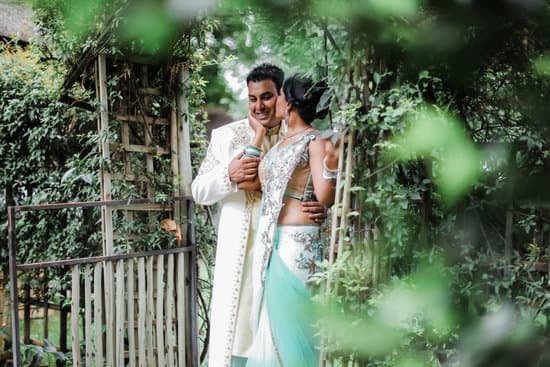Wedding rings hold a special place in the hearts of couples, signifying their eternal love and commitment to each other. The question often arises: where do you wear your wedding ring? This seemingly simple inquiry actually opens up a world of traditions, cultural differences, and personal choices when it comes to the placement of this beloved symbol.
Throughout history, wedding rings have been worn on various fingers depending on cultural customs and beliefs. From the left hand to the right hand, the ring finger has held a special significance in many societies. However, with modern trends and evolving fashion choices, people are now exploring alternative ways to wear their wedding rings beyond the traditional finger placement.
As we delve into the evolution of wearing wedding rings, we will explore the rich symbolism and history behind placing this significant piece of jewelry on the ring finger. We will also take a look at how individuals from different backgrounds and cultures have varied practices when it comes to wearing their wedding rings, shedding light on the diversity of traditions that exist worldwide.
Tradition vs Modern Trends
Wedding rings have long been considered a symbol of love and commitment between partners. Traditionally, wedding rings are worn on the ring finger of the left hand, believed to be directly connected to the heart through the vein of love. This longstanding tradition has deep roots in many cultures around the world and is still widely practiced today. However, as society evolves, so do trends in fashion and personal expression.
In recent years, there has been a shift towards modernizing the way wedding rings are worn. Some couples choose to break away from tradition and opt for unique ways to display their commitment. For example, instead of wearing their wedding ring on their finger, some individuals choose to wear it as a necklace or bracelet. This allows for more creativity and personalization in how they showcase their love for one another.
Despite these modern trends, many people still prefer to wear their wedding ring on their traditional ring finger, honoring the history and symbolism behind this practice. In some cultures, there are specific customs associated with which hand or finger the wedding ring should be worn on.
For instance, in countries like India and Russia, the wedding ring is typically worn on the right hand instead of the left. These cultural differences highlight the diverse ways in which people express their love and commitment through wearing wedding rings.
- List of Cultural Differences in Ring Placement:
- Left Hand: Western countries such as the United States and Canada
- Right Hand: Countries like India and Russia
- Other fingers: Countries with alternative traditions such as Brazil (thumb) or Germany (middle finger)
Left Hand vs Right Hand
In many Western cultures, the tradition of wearing a wedding ring on the left hand dates back centuries. This custom is believed to have originated from the ancient Egyptians, who believed that the vein in the ring finger, known as Vena Amoris or the “Vein of Love,” was connected directly to the heart.
As a result, placing a wedding ring on this finger symbolizes a strong connection between two individuals in love. Additionally, in Christian tradition, the left hand is often considered closer to the heart and therefore more significant for displaying symbols of love and commitment.
On the other hand, various Eastern cultures have different beliefs and practices when it comes to wearing wedding rings. For example, in some countries like India and Russia, it is common for couples to wear their wedding rings on their right hand.
In Indian culture, specifically Hindu tradition, married women often wear their wedding ring on their right hand as a symbol of being married and committed to their spouse. Similarly, Russian Orthodox Christians also traditionally wear their wedding rings on their right hands.
Ultimately, whether you choose to wear your wedding ring on your left or right hand depends on personal preference or cultural background. In today’s modern society, there are no strict rules dictating which hand you should wear your ring on – it’s all about what feels most comfortable and meaningful for you personally.
So whether you decide to follow tradition and wear it on your left hand or opt for your right hand based on cultural influences or simply because it feels right for you, where do you wear your wedding ring is a decision that reflects your individual style and values.
- Western cultures often follow the tradition of wearing wedding rings on the left hand
- Some Eastern cultures like India and Russia prefer wearing wedding rings on the right hand
- Ultimately, where you choose to wear your wedding ring depends on personal preference or cultural background
Wedding Ring on the Ring Finger
The tradition of wearing a wedding ring on the ring finger dates back to ancient times when it was believed that this finger had a vein that led directly to the heart. This symbolism of love being connected to the heart has been carried through generations, making the placement of the wedding ring on this finger a universal symbol of commitment and unity in marriage.
Whether it is a simple band or a sparkling diamond ring, the significance remains the same.
In many Western cultures, including in the United States and Europe, the left hand is traditionally where you wear your wedding ring. This custom can be traced back to Roman times when they believed there was a “vena amoris” or vein of love that ran from the fourth finger of the left hand directly to the heart.
While this anatomical theory has been debunked, the tradition still holds strong in many societies. On the other hand, some Eastern cultures prefer to place their wedding rings on their right hand as a symbol of marriage and commitment.
Regardless of which hand you choose to wear your wedding ring on, what truly matters is the sentiment behind it. The ring serves as a constant reminder of love, loyalty, and devotion between partners. It stands as a promise that transcends time and distance, connecting two individuals in a bond that is both physical and emotional. Whether you wear your wedding ring on your left hand or right hand, what truly matters most is the love and commitment it represents.
| Location | Cultural Significance |
|---|---|
| Left Hand (Western Cultures) | Symbolizes connection to heart; tradition from Roman times |
| Right Hand (Eastern Cultures) | Symbolizes marriage and commitment; common practice in some countries |
Alternate Ways to Wear a Wedding Ring
One of the most common questions asked by soon-to-be-married individuals is “Where do you wear your wedding ring?” Traditionally, wedding rings are worn on the fourth finger of the left hand because it was believed that this finger has a vein that is directly connected to the heart. However, in modern times, there are various ways in which people choose to wear their wedding rings.
While the traditional placement on the ring finger remains popular, some couples opt for alternative ways to wear their wedding rings. For those who may not be able to wear a ring on their fingers due to work restrictions or personal preferences, necklaces and bracelets have become popular alternatives. Some individuals choose to hang their wedding ring on a necklace chain close to their heart as a symbol of their love and commitment.
Others may prefer wearing their wedding ring on a bracelet wrapped around their wrist. This option allows for the ring to be constantly visible, serving as a reminder of the bond shared between partners. The versatility and creativity involved in finding alternate ways to wear a wedding ring showcase how personal and customizable this tradition can be for each couple.
| Wearing Options | Description |
|---|---|
| Necklace | Hanging the ring on a necklace chain close to the heart |
| Bracelet | Wrapping the ring around the wrist as a constant reminder |
Personal Stories
The Everyday Reminder
For many individuals, wearing their wedding ring is a constant reminder of the love and commitment they share with their partner. Some choose to wear their ring on their left hand as tradition dictates, while others opt for different fingers or even alternate ways of displaying it. Regardless of where they wear it, the wedding ring serves as a symbol of unity and everlasting love in their lives.
The Creative Expression
In today’s modern world, some people have taken a more creative approach to wearing their wedding rings. Instead of following traditional norms, they explore unique ways to showcase this meaningful piece of jewelry. From wearing the ring on a necklace close to their heart to incorporating it into a bracelet or anklet, these individuals find innovative ways to keep the essence of their marriage close to them at all times.
The Intimate Connection
For some couples, the significance of wearing a wedding ring goes beyond just fulfilling a tradition or showcasing commitment. It serves as an intimate connection between partners, especially in long-distance relationships or during times when physical distance separates them. By wearing their wedding rings in unconventional ways or places, they feel connected and reassured of the bond they share, no matter how far apart they may be physically.
Practical Tips for Wearing Your Wedding Ring
When it comes to wearing your wedding ring, there are some practical tips to keep in mind to ensure that your precious symbol of love stays safe and secure. One of the most important things to consider is the fit of your ring.
It’s crucial that your wedding ring fits comfortably on your finger, not too tight that it cuts off circulation, but not too loose that it risks falling off. If needed, consider getting your ring resized by a professional jeweler for the perfect fit.
Another tip for wearing your wedding ring is to avoid wearing it when doing activities that could potentially damage or scratch the metal or stones. Activities such as gardening, exercising with weights, or even swimming in chlorinated pools can all cause wear and tear on your ring. It’s best to take off your ring and store it safely during these activities to preserve its longevity.
Additionally, regularly cleaning and maintaining your wedding ring is essential to keep it looking shiny and new. Use a gentle jewelry cleaner specifically designed for the type of metal and gemstones in your ring. Regularly polishing your ring will help remove any dirt, oils, or residue that may accumulate from everyday wear. Taking care of your wedding ring will not only maintain its beauty but also ensure that it stays in good condition for many years to come.
Fashion and Style
When it comes to fashion and style, one important aspect that often gets overlooked is how to match your wedding ring to your outfit. While the focus is usually on the dress, shoes, and accessories, the wedding ring plays a significant role in completing your overall look. The right wedding ring can enhance your outfit and add a touch of elegance or sophistication.
Choosing the right wedding ring that complements your outfit can make a big difference in your overall appearance. For example, if you are wearing a simple and elegant outfit, a classic and timeless wedding ring design might be the perfect choice. On the other hand, if you are going for a more modern and edgy look, you may opt for a unique and bold wedding ring that stands out.
It’s important to consider the color of your outfit as well when choosing a wedding ring. For neutral or monochromatic outfits, you have more freedom to play with different metal tones like white gold, yellow gold, or rose gold.
If you are wearing colorful attire, you may want to choose a wedding ring that complements or matches one of the colors in your outfit. Ultimately, your wedding ring should enhance your overall look and reflect your personal style no matter where do you wear your wedding ring.
Conclusion
In conclusion, the wedding ring holds a significant place in our society, symbolizing love, commitment, and unity between partners. It has evolved over time from traditional customs to modern trends, with various cultural differences in terms of which hand it is worn on. The symbolism and history behind wearing the wedding ring on the ring finger are profound and continue to be cherished by couples around the world.
While the classic way of wearing a wedding ring is on the left hand’s ring finger, some people have opted for alternative ways such as wearing it on a necklace or bracelet. Personal stories shared by individuals about where they wear their wedding rings reflect the uniqueness and individuality of each relationship.
Whether it’s matching your outfit or considering practical tips for everyday wear, how you choose to display your wedding ring is a personal choice that should be meaningful to you and your partner.
Ultimately, no matter where you wear your wedding ring – whether it’s on your left hand’s ring finger traditionally or as a necklace – the importance lies in the love and commitment it represents. It serves as a constant reminder of the vows exchanged on your special day and signifies the bond between two individuals. So, wherever you go, let your wedding ring be a symbol of enduring love and devotion that you carry with pride.
Frequently Asked Questions
Is It OK to Wear Wedding Ring on Right Hand?
It is not traditional to wear a wedding ring on the right hand in most Western cultures. The left hand is typically chosen for wearing both engagement and wedding rings, symbolizing love and commitment.
Where Do You Put Your Ring When Married?
When married, it is customary to wear your wedding ring on the ring finger of your left hand. This tradition dates back centuries, with the fourth finger being believed to have a special vein connected directly to the heart, symbolizing eternal love.
Which Finger Is for Wedding Ring?
The finger traditionally reserved for the wedding ring is the fourth finger of the left hand, also known as the ring finger. This custom has been followed in many cultures and is seen as a universal symbol of commitment and partnership between spouses.

I have been involved in marriages for over 20 years helping couples and singles understand more about them.





